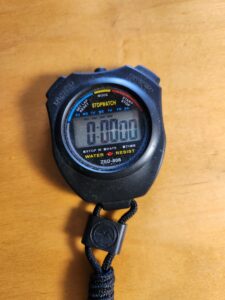We sing on held breath … not loose air.
Wrap your arms around you and give yourself a firm hug. Now take in a big breath. Feel the lower back expand and the ribs go outward. That is where you breathe to (your lower lungs) when you take a big breath. You will have 30% more air and you never have enough air when you are singing. Elvis used his lower lungs as evidenced by some of his long verses he sung on one breath.
Hold Your Breath – Exercise 1

Get a cheap digital stopwatch. Inhale as much as you can including the lower lungs in your back. Start your stopwatch and hold your breath for as long as you can. When you need to exhale stop the stopwatch and note the time you have held your breath. Keep practicing this throughout the day so you will increase the time you can hold your breath. You should be able to double the time from when you fist started practicing. Go to your limit.
Exhale It All – Exercise 2
Take a deep breath then exhale all the air. At the end of your exhale hold your breath for 3 to 5 seconds. The exhale some more. You will be able to exhale more.
Diaphram – Exercise 1
Start on the A below middle C. Do the same basic tune up exercise with the 5 notes but this time hold each note for at least a slow 8 count (or more). Feel your diaphram collapsing as the stomach muscles consitantly tighten. There should be no variance to the tone in pitch or volume of the note. Do this in all vowels. Use a metronome. Both the nasal cavity and the chest cavity should be chambers for the sound.
You can check your voice scientifically by using a DAW like Cubase. Record your voice and then use the Variaudio menu item. You will see your pitch variance compared to the note.